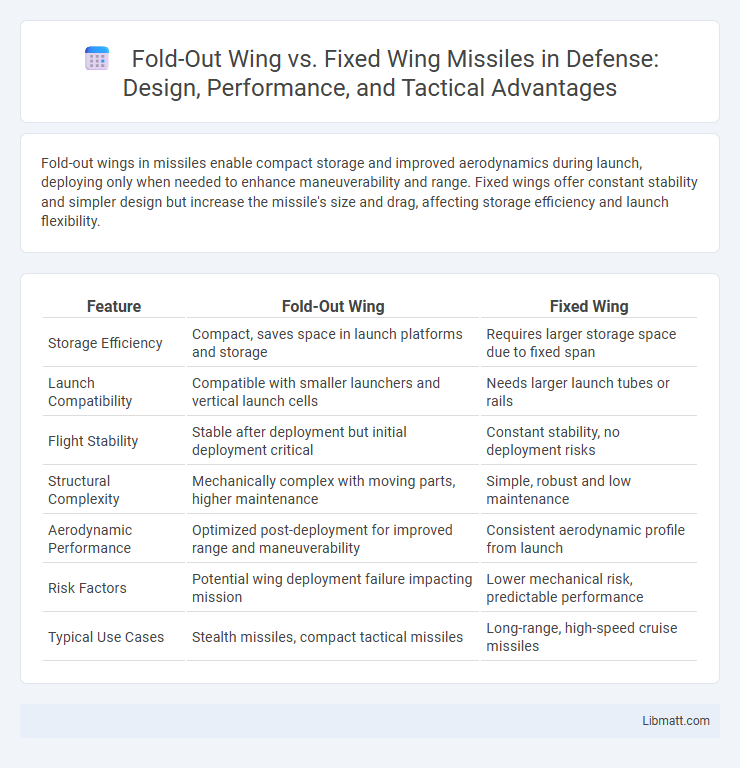Fold-out wings in missiles enable compact storage and improved aerodynamics during launch, deploying only when needed to enhance maneuverability and range. Fixed wings offer constant stability and simpler design but increase the missile's size and drag, affecting storage efficiency and launch flexibility.
Table of Comparison
| Feature | Fold-Out Wing | Fixed Wing |
|---|---|---|
| Storage Efficiency | Compact, saves space in launch platforms and storage | Requires larger storage space due to fixed span |
| Launch Compatibility | Compatible with smaller launchers and vertical launch cells | Needs larger launch tubes or rails |
| Flight Stability | Stable after deployment but initial deployment critical | Constant stability, no deployment risks |
| Structural Complexity | Mechanically complex with moving parts, higher maintenance | Simple, robust and low maintenance |
| Aerodynamic Performance | Optimized post-deployment for improved range and maneuverability | Consistent aerodynamic profile from launch |
| Risk Factors | Potential wing deployment failure impacting mission | Lower mechanical risk, predictable performance |
| Typical Use Cases | Stealth missiles, compact tactical missiles | Long-range, high-speed cruise missiles |
Introduction to Missile Wing Designs
Missile wing designs primarily include fold-out wings and fixed wings, each serving unique aerodynamic and storage purposes. Fold-out wings deploy after launch to reduce missile size during transportation and launch, optimizing stealth and compactness. Fixed wings, though less compact, provide consistent aerodynamic stability and control, often favored in missiles where immediate flight readiness is critical.
Overview of Fold-Out Wing Missiles
Fold-out wing missiles feature retractable wings that remain compact during launch and deployment, optimizing aerodynamics and storage efficiency. These wings expand mid-flight, enhancing maneuverability and stability without compromising the missile's initial stealth profile. Your choice of fold-out wing missiles supports versatile mission requirements by combining compact design with improved aerodynamic control.
Overview of Fixed Wing Missiles
Fixed wing missiles feature rigid, non-movable wings that provide consistent aerodynamic stability and extended flight range, making them ideal for long-distance precision strikes. Their fixed-wing design enables higher speeds and improved lift-to-drag ratios compared to fold-out wing variants, enhancing overall missile performance. You benefit from increased reliability and simpler mechanical construction, which often results in lower maintenance requirements and improved operational readiness.
Aerodynamic Performance Comparison
Fold-out wings on missiles enhance aerodynamic performance by reducing drag during launch and increasing lift in flight, improving maneuverability and range compared to fixed wings. Fixed wings offer consistent aerodynamic properties with simpler design but may compromise compactness and launch efficiency. You can optimize missile performance by balancing the wing type based on mission-specific aerodynamic requirements.
Launch and Storage Considerations
Fold-out wings in missiles enable compact storage within launch tubes or tight compartments, facilitating stealth and ease of deployment from confined spaces such as submarines or aircraft bays. Fixed wings, while offering structural simplicity and immediate aerodynamic stability upon launch, require larger storage areas and can limit the missile's compatibility with certain launch platforms. The choice between fold-out and fixed wings significantly impacts missile launch mechanisms and storage efficiency, influencing overall mission flexibility and platform integration.
Flight Stability and Maneuverability
Fold-out wings on missiles enhance maneuverability by allowing larger wing surfaces to deploy in-flight, improving lift and control during complex maneuvers. Fixed wings provide consistent flight stability due to their rigid structure, ensuring predictable aerodynamic behavior at high speeds and long distances. The trade-off lies in fold-out wings offering adaptive flight control for varied mission profiles, while fixed wings favor stable, straightforward trajectories.
Deployment Speed and Reaction Time
Fold-out wing missiles offer rapid deployment by compactly storing wings during launch and swiftly extending them mid-flight, significantly reducing reaction time in dynamic combat scenarios. Fixed-wing missiles have longer preparation times due to their rigid structure, which can delay launch readiness and reduce responsiveness to fast-moving targets. The enhanced deployment speed of fold-out wings enables quicker trajectory adjustments, improving overall mission effectiveness against agile threats.
Durability and Reliability Factors
Fold-out wings in missiles are engineered for compact storage and deployment, but their moving parts introduce potential points of mechanical failure, impacting long-term durability and reliability. Fixed wings, being integral and static components, offer greater structural robustness and consistent aerodynamic performance under extreme conditions. Your choice should weigh mission requirements against the need for proven durability, as fixed-wing designs typically outperform fold-out wings in reliability over repeated use and harsh environments.
Applications and Mission Suitability
Fold-out wing missiles excel in applications requiring compact storage and stealth, such as submarine-launched or air-launched scenarios where space constraints are critical. Fixed-wing missiles offer superior aerodynamic stability and range, making them ideal for long-distance strikes and sustained flight missions. Your choice between fold-out and fixed wing depends on the deployment environment and mission profile to optimize performance and operational effectiveness.
Future Trends in Missile Wing Technology
Future trends in missile wing technology emphasize fold-out wing designs to enhance compact storage and launch versatility, enabling deployment from confined spaces such as vertical launch systems and underwater platforms. Advances in materials and micro-mechanical actuators improve the reliability and aerodynamic efficiency of fold-out wings, allowing for extended range and maneuverability compared to traditional fixed-wing configurations. Your missile systems will benefit from increased stealth capabilities and reduced radar cross-section, making fold-out wings a critical component in next-generation missile innovation.
fold-out wing vs fixed wing (missiles) Infographic

 libmatt.com
libmatt.com